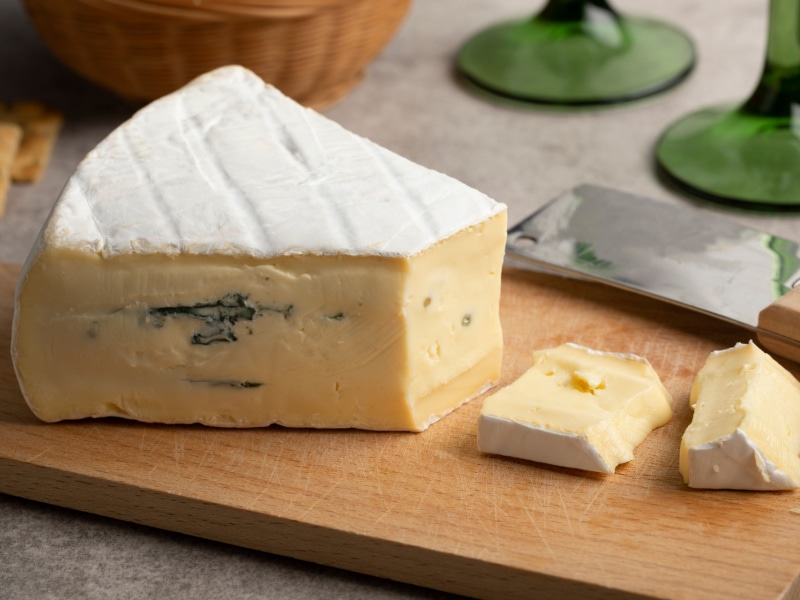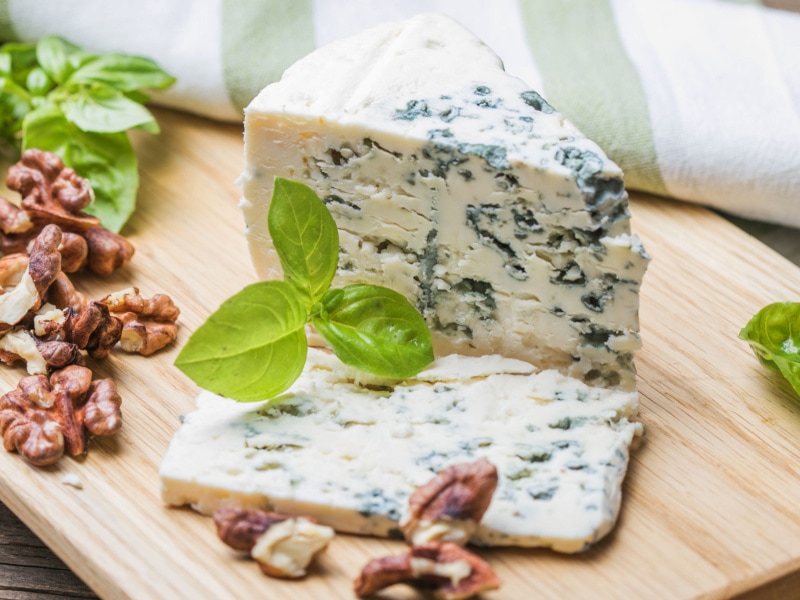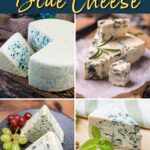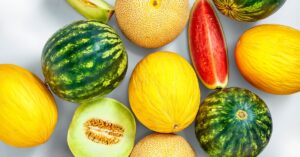The different types of blue cheese include Roquefort, Stilton, gorgonzola, and more irresistible varieties!
If you like your cheese pungent and salty, chances are blue cheese has already found its way into your heart. It might be sitting in your fridge, crumbled for a dip, sauce, or dressing.

Whether on pizza or a charcuterie board, blue cheese has an undeniable charm.
But did you know there are plenty of blue cheese varieties outside of the ones you use every day? So if you thought you only had one option, good news! There are 15 different blue cheese varieties for your tastebuds to discover.
Let’s take a closer look, shall we?
What Is Blue Cheese?
Blue or bleu cheese is characterized by blue-green spots or veins through it.
To be clear, blue cheese doesn’t refer to just one type of cheese. It’s a blanket term for cheeses with Penicillium mold injected into them during production.
These Penicillium strains, Penicillium roqueforti and Penicillium glaucum, are perfectly safe to eat.
Blue cheese has a strong, salty, and sometimes sweet flavor. It’s often semi-soft, crumbly, or creamy. It’s great with fruits, nuts, salads, and dressings.
However, each type of blue cheese has unique characteristics that set it apart. The aroma can be mild or very strong. Textures can range from soft to hard. And they can taste mild or very salty and sharp.
They can also be made with cow, sheep, goat, or buffalo milk. The mold is added at different stages of production.
There are many popular types of blue cheese. French Roquefort, British Stilton, Italian Gorgonzola, and Danish Blue are just a few of them.
Types of Blue Cheese
Traditional
There are many kinds of blue cheese, but five standout varieties have stood the test of time. These traditional classics are produced under strict regulations.
They’ve earned PDO (protected designation of originor) and PGI (protected geographical indication) statuses from the European Union.
These indications reflect their authenticity and regional significance.
1. Roquefort

French Roquefort, or “King of Cheeses,” as some call it, is often considered the original blue cheese.
According to legend, a young shepherd from Roquefort-sur-Soulzon left his bread and cheese in a cave while chasing a girl. When he returned, he found his lunch transformed by mold but decided to taste it anyway. The rest is history.
Roquefort is made from ewe’s milk. It offers the strongest aroma and flavor among blue cheeses. It has a pungent smell and a sharp, highly salty, and acidic taste. Its texture is crumbly yet creamy, hosting bright blue-green veins in its dark white body.
Roquefort goes well with rye bread, honey, and quince paste. The French dessert wine, Sauternes, is also a favorite accompaniment.
2. Stilton

English Blue Stilton cheese dates back over 300 years. Known fondly as “the King of English Cheeses,” it holds a special place in the U.K.’s cheese portfolio.
Stilton is made with full cream pasteurized cow’s milk. Its rich, creamy texture results from its 48% milk fat content. The cheese is crumbly yet creamy, with a fresh and tangy flavor.
Interestingly, Stilton’s production is geographically specific. Ironically, though, the town of Stilton is outside this region. The area’s proximity to London contributed to the cheese’s early success, enabling easy transport to the market.
Stilton is famously paired with port, a sweet, rich Portuguese wine. While many drench the cheese in the wine, experts say it’s best to sip it separately.
Try Stilton with ripe pears, walnuts, and plain water crackers for a true taste of British delight. And of course, don’t forget the port wine.
3. Gorgonzola

Unlike most blue cheeses, Gorgonzola uses Penicillium Glaucum, offering a unique taste profile. If you’ve had quatro formaggi pizza, pasta sauce, or a dressing, you’ve likely tasted Gorgonzola.
This Italian cheese comes in two main types: dolce and piccante.
The milder, sweeter, and creamier ‘dolce’ is perfect for cheese boards. It tastes divine when drizzled with honey.
‘Piccante’ or ‘Mountain Gorgonzola’ is sharper, crumblier, and aged longer. It’s ideal for salads where its texture shines.
4. Cabrales

Spanish Cabrales is unique among blue cheeses. Unlike most blue cheeses, it’s crafted from one, two, or even three milk varieties.
It can be made from raw, unpasteurized cow, goat, or sheep milk, providing a distinct flavor palette.
Hailing from the Asturias region in northern Spain, Cabrales is a product of its mild, Atlantic climate.
Cabrales has a striking appearance. It features a darker, yellowish paste riddled with blue-gray veins.
It’s firm yet creamy because of its high-fat content, at least 45%. The flavor is robust, salty, and slightly spicy. It grows sharper and more acidic as the cheese ages.
Cabrales is a limited, artisanal product due to its traditional, small-scale production methods. Each piece at the cheese counter is a testament to Spanish craftsmanship.
5. Danish Daniblue

Danablu, or Danish Blue, is one of only three Danish cheeses with PGI status from the European Union. Crafted from full-fat pasteurized cow’s milk, Danablu presents as white or pale yellow.
It’s a balanced blue cheese, sitting comfortably between pungency extremes. It’s not too crumbly or creamy and delivers a sharp flavor.
The homogenized milk used in its production gives it a creamy mouthfeel and a clean, white appearance. The result is a cheese where the “blue” flavor takes center stage.
Danablu is versatile, serving well as a snack or crumbled in salads. Plus, the high calcium content makes this delicious 25% fat cheese a less guilty indulgence.
Modern Blue Cheese
These 10 varieties aren’t as prominent or widely consumed as the 5 classics. But they’ve also carved out their niche.
They’ve drawn attention for their unique qualities, gaining popularity among cheese lovers.
6. Cambozola

Cambozola, a hybrid of Camembert and Gorgonzola, is a rich, indulgent blue cheese. It’s a relatively new addition to the world of cheese. It originated in the 1970s from southern Germany.
As a double-cream blue cheese, it’s made from both cow’s milk and cream. It also features a bloomy, edible rind akin to Brie cheese.
It has a robust aroma and a sharp, buttery, nutty flavor with a hint of sweetness.
Remarkably, this rich, creamy cheese becomes lactose-free during maturation. If your body can’t process milk sugar, Cambozola is an excellent choice.
Enjoy Cambozola on a cheese plate with crackers to appreciate its texture and mild “blue” flavor. Or, pair it with grapes or dried fruit for a delightful snack.
7. Fourme d’Ambert

Fourme d’Ambert is one of France’s oldest cheeses, tracing back to Roman times. It was named after the old Latin word for cheese. Fourme d’Ambert refers to its typical round, cylindrical shape.
Crafted meticulously for years, this ancient cheese is unsurprisingly exquisite.
Unlike many blue cheeses, Fourme d’Ambert doesn’t assault your tastebuds immediately. Instead, its intensity builds gradually. Its salty punch is balanced by a creamy texture. So it’s all too easy to eat a lot at once!
This cheese is made from raw cow’s milk. It has distinct dark-blue veins, a creamy texture, and a mild, slightly earthy flavor.
As with other blue cheeses, it pairs perfectly with sweet wines. It’s also traditionally used in blue cheese soufflés.
8. Bleu d’Auvergne

Bleu d’Auvergne is a moist yet crumbly cheese with a sharp, spicy, grassy flavor. It hails from Auvergne in France and is crafted from raw cow’s milk.
Sometimes referred to as the “cow’s milk Roquefort,” it’s a true delight for blue cheese enthusiasts. It’s rich in blue mold veins that deliver a punchy, salty bite.
Per the standards, this cheese must contain at least 50% fat, resulting in a creamy and indulgent taste.
Bleu d’Auvergne made its market debut only in the mid-20th century, making it a relative newcomer. Despite its recent origin, it’s highly regarded and doesn’t compromise on quality.
Serve this cheese on buttered bread or a slice of apple to counterbalance its salty tang. For the best flavor, serve it at room temperature, not straight from the fridge.
9. Rogue River Blue
Oregon’s Rogue River Blue is one of America’s best contributions in the blue cheese category. In 2019, it won the world’s best cheese title at the World Cheese Awards. That’s a first for an American cheese!
What sets it apart is its unique preparation method. The cheese gets enveloped in wine grape leaves soaked in pear spirits. This introduces complex layers of fruity and astringent notes.
As the cheese matures, it develops crystals that cheese aficionados treasure. It’s best enjoyed alone or with a simple fruit pairing.
With its World Cheese Awards win, demand for Rogue River Blue has soared. It’s a seasonal cheese, though, so you can’t enjoy it all year round. Milk collection happens only in the fall when it’s notably sweet and complex.
10. Saint Agur

Saint Agur is a blue cheese with a creamy, buttery taste and soft texture.
This French blue cheese offers a milder flavor compared to bolder blues. It’s a good choice if you’re new to blue cheese.
Saint Agur is ripened just for 60 days, unlike long-aged blues, so it doesn’t get overly funky.
It was created by the French dairy company Bongrain in 1988. But it’s become popular thanks to its unique blend of creamy softness and subtle blue cheese funk.
Its high butterfat content of 60% categorizes it as a double cream cheese.
The cheese wheels are hexagonal, making it easy to cut into neat wedges. Since it’s so creamy, it pairs well with sweet things like fruit or jams. Try it with fig jam on a cracker for a flavorful treat.
11. Valdeon

Like Cabrales, Spanish Valdeon has a spicy flavor, leaning heavily towards the “blue” taste. This cheese is traditionally aged and wrapped in sycamore leaves. This lends the cheese a subtle flavor.
It used to be a variant of Cabrales. However, only cheese from the Cabrales town could bear the name. So Valdeon carved out its own identity.
Its bold, tangy taste pairs well with sweet treats. For instance, quince paste’s concentrated sweetness perfectly balances the salty cheese.
12. Maytag Blue

Maytag Blue is an American cheese from Newton, Iowa. It’s made from homogenized but unpasteurized cow’s milk, creating a creamy and rich cheese.
Frederick L. Maytag II developed this cheese in 1941, trying to mirror the famous French Roquefort. He used the best milk from his family’s herd and the same mold strain as Roquefort.
To copy the conditions that give Roquefort its world-renowned status, Maytag aged his cheese in local caves.
13. Shropshire Blue

Shropshire Blue is a bright orange-blue cheese hailing from the UK. It’s a blend of Stilton and another English cheese, Cheshire. It gets its vibrant color from the natural dye annatto. The combination of this orange color with blue veins creates a unique appearance.
This cheese holds a respectable reputation. It won “Supreme Champion,” “Best English Cheese,” and “Best Blue Cheese” at The British Cheese Awards in 2016.
Its exceptional salty flavor justifies this prestige. Like Stilton, Shropshire Blue is best enjoyed with a glass of port.
14. Buttermilk Blue

Despite its name, buttermilk blue cheese comes from fresh cow’s milk. It’s a mild blue cheese, perfect for those trying this variety for the first time.
The cheese earns its name from the tangy flavor it develops as it matures.
The Roth family, originally from Switzerland, created this cheese. Their international perspective on cheese-making produced European-style cheese suited to American tastes.
The quality of their cheese is reflected in the many awards they’ve won. In 2022, Roth took home two Best of Class wins at the World Championship Cheese Contest.
15. English Wensleydale Blue

Wensleydale Blue is a variation of classic Wensleydale, traditional British cheese. It’s produced by adding penicillin mold during the cheese-making process.
Wensleydale cheese is often combined with various ingredients, such as dried fruit or honey. The addition of mold was a natural evolution.
The idea came from 19th-century cheesemaker Thomas Nuttall.
The flavor of Wensleydale Blue is milder than that of Roquefort, Cabrales, or English Blue Stilton. Its taste resembles Danablue or Gorgonzola Dolce. It provides a less intense blue cheese experience.











